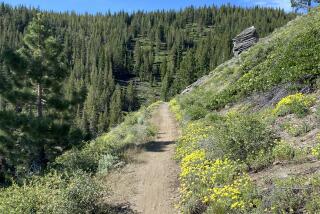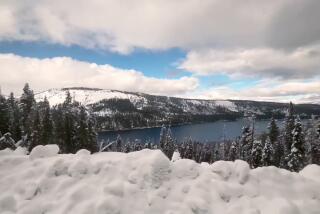Covering the Sierra High Route by ski
After Barry Ohm met mountain guide Dave Beck, Ohm knew he had to ski across the Sierra.
Ohm, a seasoned climber who was living in South Lake Tahoe in 2009 when he took a winter survival class from Beck, was enthralled with Beck’s tales of skiing in the “old days.”
Ohm took a series of wilderness ski-camping courses, and in May 2010, he signed on with Alpine Skills International to ski the Sierra High Route, which runs through Sequoia National Park and wilderness areas of the Inyo National Forest. The six-day mountaineering traverse crosses nine mountain passes at elevations from 10,500 feet to 13,000 feet.
Carrying a 40-pound pack, Ohm skied the route, which begins in Wolverton, on the west side of the Sierra, and covers about 40 miles before ending near Independence. It leads skiers over high ridges, glaciated plateaus and cirques. The route also features spectacular alpine views and long downhill runs on what is usually fun-to-ski corn snow.
“It was something of a rite of passage for me,” said Ohm, 50. “If you’ve skied the Sierra High Route, it’s sort of like you have done something that — while not exactly elite, perhaps — is certainly respectable.”
Otto Steiner, an Austrian immigrant, pioneered the traverse in 1931. Starting in Wolverton and traveling alone, he completed his crossing in three days. For good measure, he threw in an ascent of Mt. Whitney, elevation 14,505 feet and the tallest peak in the lower 48.
Beck popularized the traverse in the 1970s and inspired Alpine Skills owners Bela and Mimi Vadasz to begin guiding the route in the early 1980s. For Ohm, who learned to climb on the big rocks east of San Diego, time stood still while he was on the traverse.
“This wasn’t so much about skiing steep couloirs for me,” he said. “It was getting away and traveling across the mountains with a small group of friends.” He used light alpine touring gear with bindings that lift free at the heel for climbing and can be secured again for more controlled descents.
Ohm has hiked the John Muir Trail, where he encountered as many as 20 people a day. “But this was a much better experience because there were no other people besides our small group,” he said.
“It was quiet and pristine. We were up at 13,000 feet and if you saw a bird, it was a big deal. I’ve backpacked all over the Sierra, but this was the best.”
He said the hardest part was mastering the skill needed to ski with a pack on his back. Nor was it easy, at the start, to “skin” up 2,000 vertical feet on his alpine touring skis. (Ohm used synthetic skins of nylon fabric strapped to the bottom of his skis to gain traction on the snow.)
“Then there were some spots on a few places where it was really steep, and I had to ‘survival ski’ down the pitches,” he said.
Ohm enjoyed the long 3,000-foot descent on corn snow in the Super Bowl down to Mahogany Flat. But he said the best part of the trip was covering long distances on his skis.
“Truth be told, at least 60% of the trip is skinning up slopes and touring,” he said. “It’s not like at a resort with lifts. Only 30 to 40% is downhill skiing, and you had to work for it.
“The trip was all about going across a major mountain range on skis, which is a fabulous way to travel. People forget how big the Sierra is because it is so accessible. But it has 14,000-foot peaks and huge expanses of wilderness.”
Peter Leh, who has been guiding the High Route trip for 30 years, said people who want to do the Sierra High Route should consider Alpine Skill’s two-day Sugar Bowl to Squaw Valley tour to learn and practice its ski camping system.
“You need to be a solid skier, in good shape and preferably have some mountaineering skills,” Leh said. “It’s demanding, but a spectacular trip if you’re up to it.”
Sierra High Route tours take place the first or second week of May when freeze-and-thaw cycles create ideal spring “corn snow” conditions, also known as “hero snow.” It is relatively easy to ski on.
“Last year, we were cutting turns until after 6 p.m. because the sun was still out,” Leh said. He sometimes logs as many as 25,000 vertical feet on the traverses because he climbs high to get long ski runs, often after setting up camp in the afternoons.
“It’s like the mountainside has been groomed baby-bottom smooth,” he said. “And besides the incredible scenery, the fantastic skiing conditions are one of the main reasons I keep coming back year after year.”
More to Read
Sign up for The Wild
We’ll help you find the best places to hike, bike and run, as well as the perfect silent spots for meditation and yoga.
You may occasionally receive promotional content from the Los Angeles Times.






